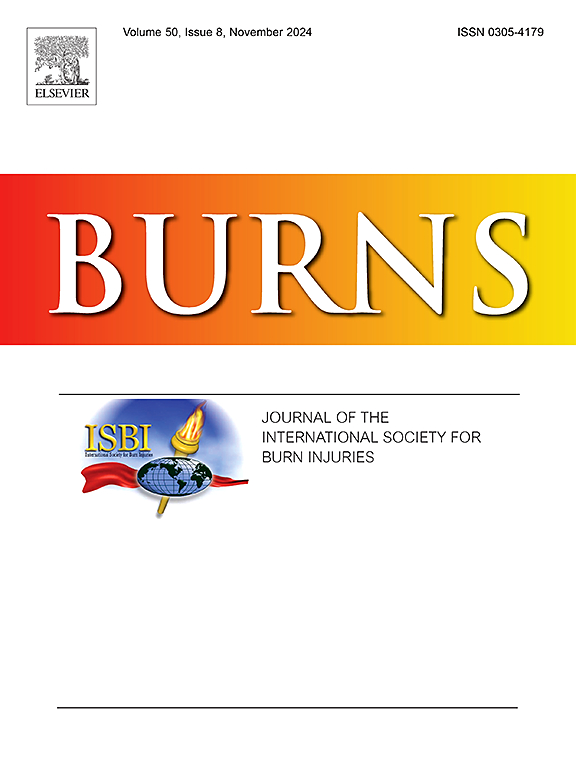宫颈扩张器囊的生物力学和组织学结果
IF 3.2
3区 医学
Q2 CRITICAL CARE MEDICINE
引用次数: 0
摘要
扩张囊是在组织扩张器周围形成的纤维膜。然而,其结果仍不明朗。在这里,我们研究了取出扩张器后留在体内的宫颈胶囊的生物力学和组织学结果。方法收集29例人宫颈扩张器的深、浅囊作为实验组。29例患者均有面部及颈部烧伤疤痕,均行瘢痕切除及扩大皮瓣移植。根据取出膨胀器后胶囊的体内滞留时间分为四组。对照组的皮肤来自5名正常受试者。我们研究了每组胶囊的生物力学和组织学。结果胶囊厚度、杨氏模量、胶原含量、I/III型胶原比、α-SMA表达水平与胶囊的层数及体内滞留时间有显著相关性(p<0.05)。在取出扩张器后,胶囊持续存在超过24个月,胶囊的杨氏模量仍然大于正常皮肤,限制了颈部的活动。此外,一些患者会出现绳状囊挛缩和颈椎牵拉感,这可能是由于深扩张囊与阔阔肌融合所致。结论颈部扩张器取出后,胶囊可在体内存留较长时间,影响颈部轮廓和活动能力。本文章由计算机程序翻译,如有差异,请以英文原文为准。
Biomechanical and histological outcomes of a cervical expander capsule
Background
An expander capsule is a fibrous membrane that forms around a tissue expander. However, its outcome is still unclear. Here we investigated the biomechanical and histological outcomes of cervical capsules that were left in vivo after expanders were removed.
Methods
The deep and superficial capsules of 29 human cervical expanders were collected to serve as an experimental group. All 29 patients sustained facial and neck burn scars and underwent scar excision and expanded skin flap transfer. These capsules were divided into four groups based on the in vivo persistence time of the capsules following expander removal. The control group featured skin from five normal subjects. We investigated the biomechanics and histology of each group of capsules.
Results
Capsule thickness, Young's modulus, collagen content, type I/III collagen ratio and α-SMA expression level were significantly related to the layer and the persistence time of the capsule in vivo (p<0.05). Capsules persisted for more than 24 months following expander removal, the Young's modulus of the capsules remained greater than that of normal skin, limiting neck mobility. Moreover, some patients experience cord-like capsular contracture and a cervical pulling sensation, which may be attributable to the fusion of the deep expander capsules and platysma muscle.
Conclusions
Following the removal of neck expanders, the capsules can persist in vivo for a long time, affecting cervical contours and mobility.
求助全文
通过发布文献求助,成功后即可免费获取论文全文。
去求助
来源期刊

Burns
医学-皮肤病学
CiteScore
4.50
自引率
18.50%
发文量
304
审稿时长
72 days
期刊介绍:
Burns aims to foster the exchange of information among all engaged in preventing and treating the effects of burns. The journal focuses on clinical, scientific and social aspects of these injuries and covers the prevention of the injury, the epidemiology of such injuries and all aspects of treatment including development of new techniques and technologies and verification of existing ones. Regular features include clinical and scientific papers, state of the art reviews and descriptions of burn-care in practice.
Topics covered by Burns include: the effects of smoke on man and animals, their tissues and cells; the responses to and treatment of patients and animals with chemical injuries to the skin; the biological and clinical effects of cold injuries; surgical techniques which are, or may be relevant to the treatment of burned patients during the acute or reconstructive phase following injury; well controlled laboratory studies of the effectiveness of anti-microbial agents on infection and new materials on scarring and healing; inflammatory responses to injury, effectiveness of related agents and other compounds used to modify the physiological and cellular responses to the injury; experimental studies of burns and the outcome of burn wound healing; regenerative medicine concerning the skin.
 求助内容:
求助内容: 应助结果提醒方式:
应助结果提醒方式:


